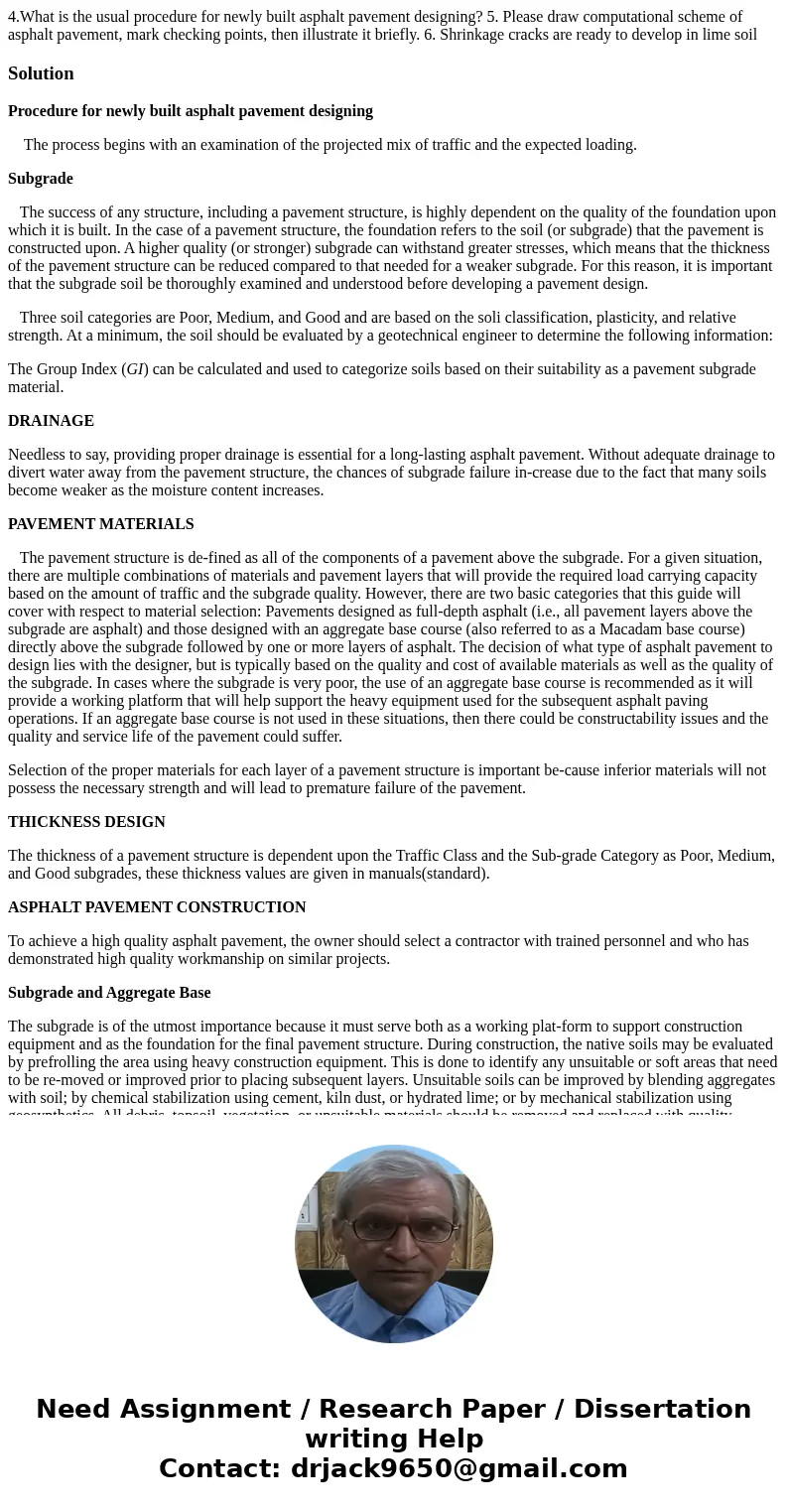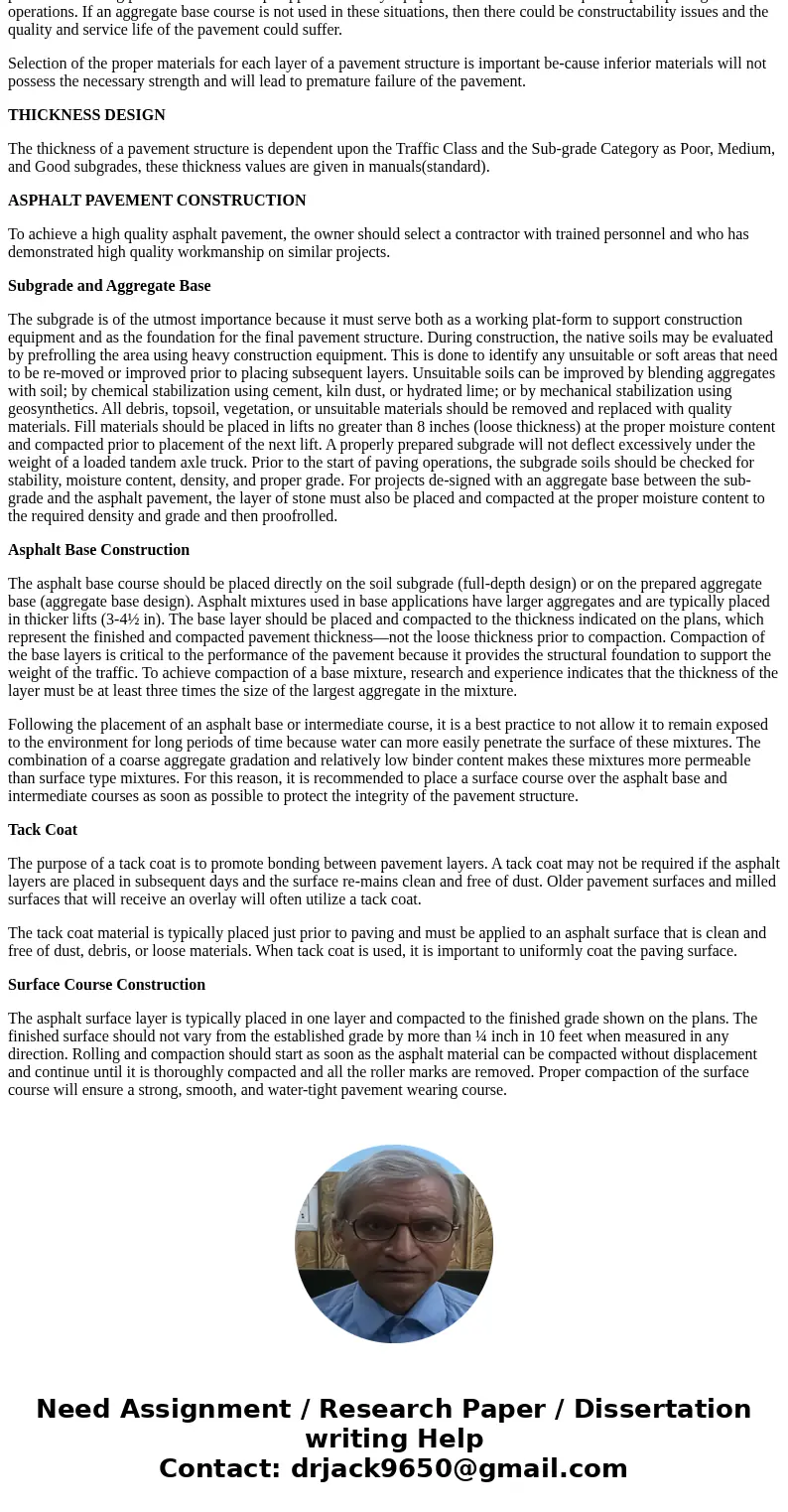4What is the usual procedure for newly built asphalt pavemen
Solution
Procedure for newly built asphalt pavement designing
The process begins with an examination of the projected mix of traffic and the expected loading.
Subgrade
The success of any structure, including a pavement structure, is highly dependent on the quality of the foundation upon which it is built. In the case of a pavement structure, the foundation refers to the soil (or subgrade) that the pavement is constructed upon. A higher quality (or stronger) subgrade can withstand greater stresses, which means that the thickness of the pavement structure can be reduced compared to that needed for a weaker subgrade. For this reason, it is important that the subgrade soil be thoroughly examined and understood before developing a pavement design.
Three soil categories are Poor, Medium, and Good and are based on the soli classification, plasticity, and relative strength. At a minimum, the soil should be evaluated by a geotechnical engineer to determine the following information:
The Group Index (GI) can be calculated and used to categorize soils based on their suitability as a pavement subgrade material.
DRAINAGE
Needless to say, providing proper drainage is essential for a long-lasting asphalt pavement. Without adequate drainage to divert water away from the pavement structure, the chances of subgrade failure in-crease due to the fact that many soils become weaker as the moisture content increases.
PAVEMENT MATERIALS
The pavement structure is de-fined as all of the components of a pavement above the subgrade. For a given situation, there are multiple combinations of materials and pavement layers that will provide the required load carrying capacity based on the amount of traffic and the subgrade quality. However, there are two basic categories that this guide will cover with respect to material selection: Pavements designed as full-depth asphalt (i.e., all pavement layers above the subgrade are asphalt) and those designed with an aggregate base course (also referred to as a Macadam base course) directly above the subgrade followed by one or more layers of asphalt. The decision of what type of asphalt pavement to design lies with the designer, but is typically based on the quality and cost of available materials as well as the quality of the subgrade. In cases where the subgrade is very poor, the use of an aggregate base course is recommended as it will provide a working platform that will help support the heavy equipment used for the subsequent asphalt paving operations. If an aggregate base course is not used in these situations, then there could be constructability issues and the quality and service life of the pavement could suffer.
Selection of the proper materials for each layer of a pavement structure is important be-cause inferior materials will not possess the necessary strength and will lead to premature failure of the pavement.
THICKNESS DESIGN
The thickness of a pavement structure is dependent upon the Traffic Class and the Sub-grade Category as Poor, Medium, and Good subgrades, these thickness values are given in manuals(standard).
ASPHALT PAVEMENT CONSTRUCTION
To achieve a high quality asphalt pavement, the owner should select a contractor with trained personnel and who has demonstrated high quality workmanship on similar projects.
Subgrade and Aggregate Base
The subgrade is of the utmost importance because it must serve both as a working plat-form to support construction equipment and as the foundation for the final pavement structure. During construction, the native soils may be evaluated by prefrolling the area using heavy construction equipment. This is done to identify any unsuitable or soft areas that need to be re-moved or improved prior to placing subsequent layers. Unsuitable soils can be improved by blending aggregates with soil; by chemical stabilization using cement, kiln dust, or hydrated lime; or by mechanical stabilization using geosynthetics. All debris, topsoil, vegetation, or unsuitable materials should be removed and replaced with quality materials. Fill materials should be placed in lifts no greater than 8 inches (loose thickness) at the proper moisture content and compacted prior to placement of the next lift. A properly prepared subgrade will not deflect excessively under the weight of a loaded tandem axle truck. Prior to the start of paving operations, the subgrade soils should be checked for stability, moisture content, density, and proper grade. For projects de-signed with an aggregate base between the sub-grade and the asphalt pavement, the layer of stone must also be placed and compacted at the proper moisture content to the required density and grade and then proofrolled.
Asphalt Base Construction
The asphalt base course should be placed directly on the soil subgrade (full-depth design) or on the prepared aggregate base (aggregate base design). Asphalt mixtures used in base applications have larger aggregates and are typically placed in thicker lifts (3-4½ in). The base layer should be placed and compacted to the thickness indicated on the plans, which represent the finished and compacted pavement thickness—not the loose thickness prior to compaction. Compaction of the base layers is critical to the performance of the pavement because it provides the structural foundation to support the weight of the traffic. To achieve compaction of a base mixture, research and experience indicates that the thickness of the layer must be at least three times the size of the largest aggregate in the mixture.
Following the placement of an asphalt base or intermediate course, it is a best practice to not allow it to remain exposed to the environment for long periods of time because water can more easily penetrate the surface of these mixtures. The combination of a coarse aggregate gradation and relatively low binder content makes these mixtures more permeable than surface type mixtures. For this reason, it is recommended to place a surface course over the asphalt base and intermediate courses as soon as possible to protect the integrity of the pavement structure.
Tack Coat
The purpose of a tack coat is to promote bonding between pavement layers. A tack coat may not be required if the asphalt layers are placed in subsequent days and the surface re-mains clean and free of dust. Older pavement surfaces and milled surfaces that will receive an overlay will often utilize a tack coat.
The tack coat material is typically placed just prior to paving and must be applied to an asphalt surface that is clean and free of dust, debris, or loose materials. When tack coat is used, it is important to uniformly coat the paving surface.
Surface Course Construction
The asphalt surface layer is typically placed in one layer and compacted to the finished grade shown on the plans. The finished surface should not vary from the established grade by more than ¼ inch in 10 feet when measured in any direction. Rolling and compaction should start as soon as the asphalt material can be compacted without displacement and continue until it is thoroughly compacted and all the roller marks are removed. Proper compaction of the surface course will ensure a strong, smooth, and water-tight pavement wearing course.


 Homework Sourse
Homework Sourse